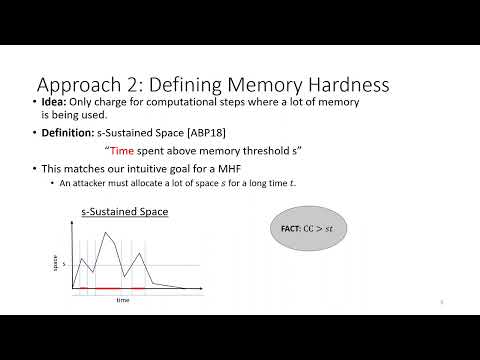CryptoDB
Sustained Space and Cumulative Complexity Trade-offs for Data-Dependent Memory-Hard Functions
| Authors: |
|
|---|---|
| Download: | |
| Presentation: | Slides |
| Conference: | CRYPTO 2022 |
| Abstract: | Memory-hard functions (MHFs) are a useful cryptographic primitive which can be used to design egalitarian proof of work puzzles and to protect low entropy secrets like passwords against brute-force attackers. Intuitively, a memory hard function is a function whose evaluation costs are dominated by memory costs even if the attacker uses specialized hardware (FPGAs/ASICs) and several cost metrics have been proposed to quantify this intution. For example, space-time cost looks at the product of running time and the maximum space usage over the entire execution of an algorithm. Alwen and Serbinenko (STOC 2015) observed that the space-time cost of evaluating a function multiple times may not scale linearly in the number of instances being evaluated and introduced the stricter requirement that a memory hard function has high cumulative memory complexity (CMC) to ensure that an attacker's amortized space-time costs remain large even if the attacker evaluates the function on multiple different inputs in parallel. Alwen et al. (EUROCRYPT 2018) observed that the notion of CMC still gives the attacker undesirable flexibility in selecting space-time tradeoffs e.g., while the MHF $\scrypt$ has maximal CMC $\Omega(N^2)$ an attacker could evaluate the function with constant $O(1)$ memory in time $O(N^2)$. Alwen et al. introduced an even stricter notion of Sustained Space complexity and designed an MHF which has $s=\Omega(N/\log N)$ sustained complexity $t=\Omega(N)$ i.e., any algorithm evaluating the function in the parallel random oracle model must have at least $t=\Omega(N)$ steps where the memory usage is at least $\Omega(N/\log N)$. In this work we use dynamic pebbling games and dynamic graphs to explore tradeoffs between sustained space complexity and cumulative memory complexity for data-dependent memory hard functions such as Argon2id and scrypt. We design our own dynamic graph (dMHF) with the property that {\em any} dynamic pebbling strategy either (1) has $\Omega(N)$ rounds with $\Omega(N)$ space, or (2) has CMC $\Omega(N^{3-\epsilon})$ --- substantially larger than $N^2$. For Argon2id we show that {\em any} dynamic pebbling strategy either(1) has $\Omega(N)$ rounds with $\Omega(N^{1-\epsilon})$ space, or (2) has CMC $\omega(N^2)$. We also present a dynamic version of DRSample (Alwen et al. 2017) for which {\em any} dynamic pebbling strategy either (1) has $\Omega(N)$ rounds with $\Omega(N/\log N)$ space, or (2) has CMC $\Omega(N^3/\log N)$. |
Video from CRYPTO 2022
BibTeX
@inproceedings{crypto-2022-32212,
title={Sustained Space and Cumulative Complexity Trade-offs for Data-Dependent Memory-Hard Functions},
publisher={Springer-Verlag},
author={Jeremiah Blocki and Blake Holman},
year=2022
}

